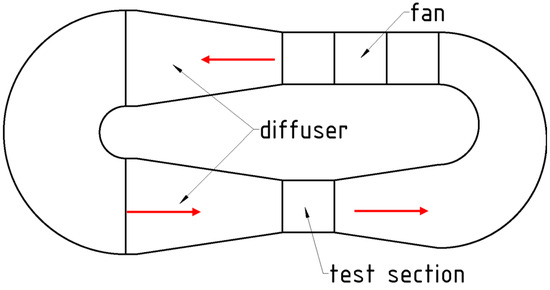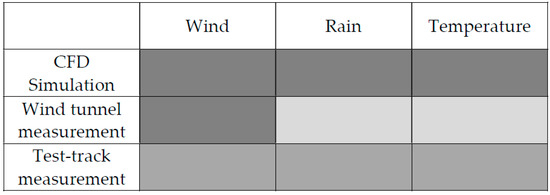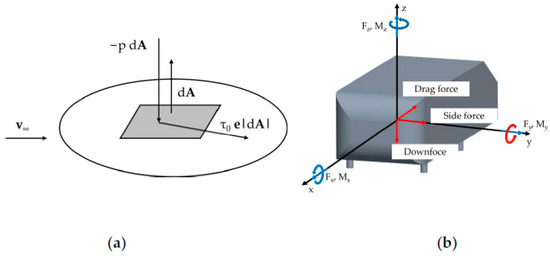Abstract
One of the most widely researched fields within the automotive industry is the effect vehicles place on the environment. To achieve a sustainable transport system, reducing the pollution of vehicles is an essential issue. The aim of this paper is to examine how weather conditions influence a vehicle’s operation. The study examines potential methods to evaluate the effect of different weather conditions on the aerodynamic parameters of a vehicle. Aerodynamic properties can be measured with the help of computational fluid dynamics (CFD), a wind tunnel and test-track measurements. On-board diagnostics are also examined to collect data on aerodynamics. These methods can monitor several parameters to measure and visualize the effects of weather conditions. The theoretical background to the related aerodynamic parameters is summarized.
1. Introduction
Electric vehicles and climate change are transforming mobility in several ways. Regulations have been introduced regarding the construction of internal combustion engines, emissions, and vehicle types in metropolitan areas. The purpose of these regulations is to reduce the impact of vehicles’ emissions on the environment. The present paper focuses on the impact of vehicles on the environment from an aerodynamic point of view. It investigates the effects of weather conditions on the aerodynamic parameters of a vehicle, which is in close connection with emission and energy efficiency. Methods to examine the effects of weather conditions and important aerodynamic parameters are compared.
The impact of vehicles and traffic on the environment is an important research field. Examinations of electric vehicle batteries are being carried out to investigate, for example, how environment temperatures influence batteries, the efficiency of the regenerative break [1,2,3,4], and the optimalization of energy efficiency in the case of electric vehicles [5,6,7,8,9]. Optimization is achieved using artificial-based networks or real-world driving data.
Vehicle aerodynamic parameters are also widely studied. The most accepted work on road vehicle aerodynamics is ’Aerodynamics of Road Vehicles’ written by Wolf-Heinrich Hucho [10]. It contains data, legal regulations and useful facts on road vehicles. Several other important research papers have been written on the topic [11,12,13,14]. Aerodynamic forces, simulation methods and additional elements that affect a vehicle’s aerodynamic properties have been analyzed in these studies.
2. Methods
Several methods are known and used to measure the aerodynamic parameters of a vehicle. Each method has its advantages and disadvantages. In order to find the most appropriate method, a detailed analysis is necessary.
2.1. Computational Fluid Dynamics (CFD)
CFD is one of the most cost- and time-efficient methods. CFD was first used in 1920 [15]. The method is based on partial differential equations (PDE) and equation systems with numerical methods. The computational volume is discretized, and fluid mechanic parameters are calculated using these discrete points [16].
Using CFD simulations, several parameters can be measured. CFD is the simplest way to identify the aerodynamic parameters of a vehicle. Pressure and velocity distribution plots can be obtained easily, whereas in a wind tunnel or a test-track measurement, parameters can be measured using less points. In CFD simulations, different weather conditions can be created. In the case of test-track measurement, weather conditions cannot be changed, thus proper planning is essential to investigate different weather conditions. CFD can be used to analyze complex problems because the software can calculate two or more phase flows.
Besides wind, which affects a vehicle’s aerodynamic parameters the most, precipitation modifies these parameters as well. Rain intensity, raindrop size, humidity and air temperature also affect energy efficiency. To examine these parameters, CFD simulation is a suitable method.
2.2. Wind Tunnel Measurement
The use of a wind tunnel is one of the most traditional ways to examine a vehicle’s aerodynamic parameters [17]. The basis of this method is using an open tunnel in which the examined vehicle is placed (Figure 1). Air is circulated in the tunnel by a fan. Flow parameters can be precisely set and modified during measurements. Therefore, wind tunnel measurement data are widely accepted and valid if the measurement report meets certain criteria.

Figure 1.
Operating principle of wind tunnel.
On the other hand, wind tunnel measurements are circumstantial. One of the most regular problems of examining a vehicle in a wind tunnel is the size of the vehicle. A wind tunnel has a maximum size of vehicle that can be placed inside it, depending on the tunnel’s dimensions, maximum flow rate, etc. [18]. If the vehicle is bigger than the maximum capacity of the wind tunnel, a scaled model must be used. Creating such a model is a time-consuming process with high costs. For the measurements, lots of sensors and certified measuring equipment are needed, which increases the costs. Also, detecting a vehicle, collecting, filtering, and evaluating the data is time consuming. Despite these difficulties, wind tunnel measurements produce valid and precise data.
2.3. Test-Track Measurement
The final measurement tool used in the research process is test-track measurement. This measurement involves the highest costs but simulates real traffic situations the most precisely.
Measuring parameters on a test track is similar to wind tunnel measurements. Sensors and certified equipment are needed to obtain adequate data. For instance, the energy efficiency of a vehicle can be measured using a fuel flow sensor, while a wind anemometer can be used to measure the actual wind speed around the vehicle. A test track is also needed, which constitutes a significant portion of the costs.
Test-track measurement gives the most precise data, but it involves the most preparation. Final decisions in connection with development processes are usually based on test-track measurements.
2.4. On-Board Diagnostics (OBD)
Using OBD tools to measure the aerodynamic parameters of a vehicle is essential today. Aerodynamic parameters cannot be measured directly in this way, but the data provide important information during measurement. Data on energy efficiency, fuel consumption and length changes of the damper can be monitored and controlled with the help of OBD [19]. Real-time data can be stored for later evaluation.
2.5. Summary of the Methods
In the previous sections, the possible measuring methods were described. In the following matrix (Figure 2), the discussed measurement tools and the measurable parameters are presented. The darker the cell in the matrix, the more efficient the measurement for the parameter. This use of color helps to visualize and understand what tools should be used for different data collection processes.

Figure 2.
Measurement tools and measurable weather condition parameters in matrix form showing the effectiveness of the pairs: the darker the cell color, the more efficient the method.
3. Theoretical Study of Vehicle Aerodynamics
To describe how a vehicle operates in different driving conditions from an aerodynamic point of view, it is important to examine the aerodynamic force acting upon it. This force consists of two parts: pressure differences and shear stress [20]. If these forces act on a unit area (Figure 3a), the aerodynamic force can be calculated as follows:
where p is local pressure, pinf is the pressure in the free-stream zone, τ0 is local shear stress, and e is a unit vector. In the first part of the equation, pressure difference is integrated in the unit surface, so the force acts perpendicular to the unit surface. The second part of the equation calculates the force from shear stress by integrating the multiplication of local shear stress and the unit vector, which gives the direction of the force.

Figure 3.
(a) Aerodynamic force acting on a unit surface. (b) Components of aerodynamic forces and moments.
In vehicle aerodynamic applications, the aerodynamic force is divided into three components (Equation (2)): drag force, side force, and lift force (downforce) (Figure 3b).
As well as the force components, there are three moments to consider: roll moment (x axis), pitch moment (y axis), and yaw moment (z axis).
From the aerodynamic forces, the drag and lift coefficients can be calculated as:
where cD is the drag coefficient, cL is the lift coefficient, ρ is the density of the flow, v is the velocity in the free-stream zone, and A is the projection of the vehicle (Figure 4). Using these forces, moments, and coefficients, the basic aerodynamic behavior of a vehicle can be described and predicted.

Figure 4.
Explanation of projection area (gray surface) of a vehicle; in this case, that of the Ahmed body (green body).
4. Relevance
According to a number of publications in the field of energy efficiency in electric vehicles, examining the effect of weather conditions on a vehicle’s aerodynamic parameters is highly important and relevant today. Different weather effects should be analyzed. The influence of rain droplet size, humidity and mass flow on the drag coefficient is to be studied further. Air temperature can affect the drag coefficient as well. Cumulative states of precipitation and wind effects that influence energy efficiency should also be researched.
Based on preliminary studies, weather conditions can affect a vehicle’s aerodynamic properties. There is a lack of studies in this area, but detailed examinations could prove and support this fact.
5. Summary
In this paper, the connection between weather conditions and vehicle aerodynamic properties has been studied. The results support the thesis that there are connections between weather conditions and aerodynamic properties. Possible measurement methods have been examined and relevant aerodynamic forces have been defined. Based on theoretical research, it has been proven with high probability that there is a connection between weather effects and aerodynamic properties. Further investigations are essential in this field.
Author Contributions
Conceptualization, B.P. and I.L.; methodology, B.P.; formal analysis, I.L.; investigation, B.P.; writing—original draft preparation, B.P.; writing—review and editing, I.L.; visualization, B.P.; supervision, I.L.; project administration, B.P. All authors have read and agreed to the published version of the manuscript.
Funding
The research was supported by the European Union within the framework of the National Laboratory for Autonomous Systems. (RRF-2.3.1-21-2022-00002).
Institutional Review Board Statement
Not applicable.
Informed Consent Statement
Not applicable.
Data Availability Statement
The raw data supporting the conclusions of this article will be made available by the authors on request.
Conflicts of Interest
Author Brúnó Péter was employed by the company MouldTech Systems Kft. The remaining authors declare that the research was conducted in the absence of any commercial or financial relationships that could be construed as a potential conflict of interest.
References
- Xu, H.; Liu, Y.; Li, J.; Yu, H.; An, X.; Ma, K.; Liang, Y.; Hu, X.; Zhang, H. Study on the influence of high and low temperature environment on the energy consumption of battery electric vehicles. Energy Rep. 2023, 9, 835–842. [Google Scholar] [CrossRef]
- Lee, G.; Song, J.; Lim, Y.; Park, S. Energy consumption evaluation of passenger electric vehicle based on ambient temperature under Real-World driving conditions. Energy Convers. Manag. 2024, 306, 118289. [Google Scholar] [CrossRef]
- Zhou, H.; Ma, K.; Liu, Y.; Li, J.; Yu, H.; An, X.; Liang, Y.; Xu, H.; Hu, X.; Zhang, H. Research on the influence of soak in the cold environment on the energy consumption of electric vehicles. Energy Rep. 2023, 9, 656–661. [Google Scholar] [CrossRef]
- Lee, G.; Song, J.; Han, J.; Lim, Y.; Park, S. Study on energy consumption characteristics of passenger electric vehicle according to the regenerative braking stages during real-world driving conditions. Energy 2023, 283, 128745. [Google Scholar] [CrossRef]
- Pan, Y.; Fang, W.; Zang, W. Development of an energy consumption prediction model for battery electric vehicles in real-world driving: A combined approach of short-trip segment division and deep learning. J. Clean. Prod. 2023, 400, 136742. [Google Scholar] [CrossRef]
- Jeong, J.; Ghaddar, B.; Zufferey, N.; Nathwani, J. Adaptive robust electric vehicle routing under energy consumption uncertainty. Transp. Res. Part C Emerg. Technol. 2024, 160, 104529. [Google Scholar] [CrossRef]
- Yang, D.; Liu, H.; Li, M.; Xu, H. Data-driven analysis of battery electric vehicle energy consumption under real-world temperature conditions. J. Energy Storage 2023, 72, 108590. [Google Scholar] [CrossRef]
- Sahwal, C.P.; Sengupta, S.; Dinh, T.Q. Advanced Equivalent Consumption Minimization Strategy for Fuel Cell Hybrid Electric Vehicles. J. Clean. Prod. 2024, 437, 140366. [Google Scholar] [CrossRef]
- Adedeji, B.P. A multivariable output neural network approach for simulation of plug-in hybrid electric vehicle fuel consumption. Green Energy Intell. Transp. 2023, 2, 100070. [Google Scholar] [CrossRef]
- Hucho, W.H. Aerodynamics of Road Vehicles, 1st ed.; Butterworth-Heinemann Ltd.: Oxford, UK, 1987; ISBN 9780750612678. [Google Scholar]
- Nakashima, T.; Tsubokura, M.; Vázquez, M.; Owen, H.; Doi, Y. Coupled analysis of unsteady aerodynamics and vehicle motion of a road vehicle in windy conditions. Comput. Fluids 2013, 80, 1–9. [Google Scholar] [CrossRef]
- Winkler, N.; Drugge, L.; Trigell, A.S.; Efraimsson, G. Coupling aerodynamics to vehicle dynamics in transient crosswinds including a driver model. Comput. Fluids 2016, 138, 26–34. [Google Scholar] [CrossRef]
- Fukuda, H.; Yanagimoto, K.; China, H.; Nakagawa, K. Improvement of vehicle aerodynamics by wake control. JSAE Rev. 1995, 16, 151–155. [Google Scholar] [CrossRef]
- Lee, J. Computational analysis of static height stability and aerodynamics of vehicles with a fuselage, wing and tail in ground effect. Ocean Eng. 2018, 168, 12–22. [Google Scholar] [CrossRef]
- Wei, Y. The development and application of CFD technology in mechanical engineering. IOP Conf. Ser. Mater. Sci. Eng. 2017, 274, 012012. [Google Scholar] [CrossRef]
- Kristóf, G. Computational Fluid Dynamics (in Hungarian), 1st ed.; Akadémia Kiadó: Budapest, Hungary, 2019; ISBN 978-963-454-412-8. [Google Scholar]
- Joseph, K. Race Car Aerodynamics, 1st ed.; R. Bentley: Cambridge, MA, USA, 1995. [Google Scholar]
- Vad, J.; Lukács, E. Fluid Mechanics Measurements, 1st ed.; Akadémia Kiadó: Budapest, Hungary, 2020; ISBN 9789634544845. [Google Scholar]
- Nagyszokolyai, I.; Lakatos, I. Vehicle Diagnostics (in Hungarian), 1st ed.; Typotex Kiadó: Budapest, Hungary, 2011; ISBN 9789632796611. [Google Scholar]
- Lajos, T. Basics of Fluid Mechanics (in Hungarian), 6th ed.; Academic Book: Budapest, Hungary, 2019; ISBN 9789631228854. [Google Scholar]
Disclaimer/Publisher’s Note: The statements, opinions and data contained in all publications are solely those of the individual author(s) and contributor(s) and not of MDPI and/or the editor(s). MDPI and/or the editor(s) disclaim responsibility for any injury to people or property resulting from any ideas, methods, instructions or products referred to in the content. |
© 2024 by the authors. Licensee MDPI, Basel, Switzerland. This article is an open access article distributed under the terms and conditions of the Creative Commons Attribution (CC BY) license (https://creativecommons.org/licenses/by/4.0/).